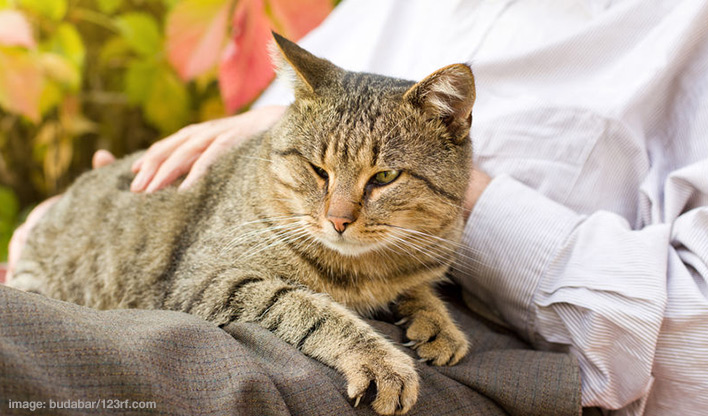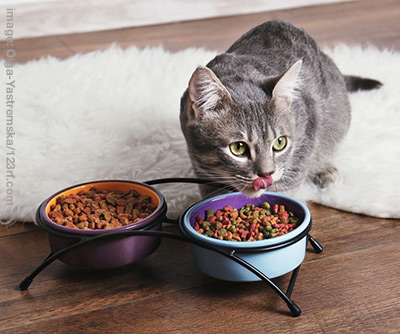Did you know that 90% of cats over the age of 12 are affected by arthritis in at least one joint?
Learn how to spot the early signs of feline arthritis. Knowing how to manage the condition will improve your cat's comfort and wellbeing.

Living with an arthritic cat
Arthritis is a very common condition that affects older cats. It is caused by painful inflammation of the joints, and you may have heard your veterinarian refer to it as ‘osteoarthritis’. The condition typically affects cats’ elbows and hips, but may also affect their wrists and ankles.
It’s been found that 90% of cats over the age of 12 have at least one joint affected by arthritis – this is a significant condition for senior cats, and for that reason we need to know how to manage it.
 If you suspect your cat has osteoarthritis, or your vet has diagnosed arthritis, there are some things you should know about living with an arthritic cat. Depending on the severity of your cat’s condition, your vet may have prescribed some painkillers to help with any soreness. In addition to this, there are modifications you can make in your home to further reduce any discomfort.
If you suspect your cat has osteoarthritis, or your vet has diagnosed arthritis, there are some things you should know about living with an arthritic cat. Depending on the severity of your cat’s condition, your vet may have prescribed some painkillers to help with any soreness. In addition to this, there are modifications you can make in your home to further reduce any discomfort.
So, how can you help your arthritic cat feel more comfortable at home?
Observe for signs of pain
Cats are experts at hiding pain, so it can be difficult to identify when there is a problem. Many of the symptoms of arthritis could be mistaken for what we’d expect old age to look like. It’s important to know what to look for so you can make adaptations if necessary.
Common signs that might tell you if your cat is experiencing discomfort from arthritis are:
- Reduced activity – he may be less able to run, chase, jump, and climb due to having sore joints. Your cat might spend more time at home instead of out hunting or exploring. He may also find it difficult or be reluctant to get up and lie down.
- Changed litter habits – you may notice that your cat is not using his litter tray and going to the toilet elsewhere in your home. He might be finding it painful to climb in and out of the litter tray if it has tall sides, so he may find somewhere else to do his business.
- Abnormal behaviour – due to the pain, arthritic cats can be sensitive to being touched in certain parts of their bodies. He may be aggressive towards you or other cats, or spend more time on his own than usual.
- Less grooming – with his stiff joints, your cat will not be as flexible as he once was. As a result, he may not be able to groom himself fully, so you may notice a change in the condition of his coat. Consider using a gentle grooming tool to help keep your cat's coat healthy.
- Lameness – the inflammation that occurs in arthritis can be sore and may limit your cat’s range of movements. Your cat may develop an abnormal gait, meaning there is a change in the way that he walks, such as limping or ‘bunny hopping’ to take weight off the affected leg.
The best way to help your arthritic cat is to monitor his behaviour to make sure he’s still comfortable, and if not, have a look at the ideas below to see what else you can do for him.
Manage his weight
If your cat is overweight, there will be extra strain on his joints which could potentially worsen the arthritis. You should arrange to have regular check-ups at the vet, where they can monitor his weight and body condition. You can discuss with the vet whether weight loss would help manage your cat’s arthritis and work together to find a suitable plan. This may include gentle exercise and a gradual change in diet, such as a reduced quantity of food or switching to a more appropriate food to help his condition. See Helping your cat get into shape.
Elevate his food bowls
 If your cat has painful joints, it may be difficult for him to bend down and reach his food and water. To prevent discomfort at mealtimes, you can keep his food and water bowls raised to the level of his head. You can buy specialized, elevated food and water bowls that will be at the right level, or you can make a makeshift platform out of boxes or other furniture to lift the bowls a little higher.
If your cat has painful joints, it may be difficult for him to bend down and reach his food and water. To prevent discomfort at mealtimes, you can keep his food and water bowls raised to the level of his head. You can buy specialized, elevated food and water bowls that will be at the right level, or you can make a makeshift platform out of boxes or other furniture to lift the bowls a little higher.
Make litter trays easy to access
Arthritic cats may find it challenging to climb in and out of their litter tray because they will be experiencing pain in their joints when they bend them. To make it easier for them, try to use a litter tray with lower sides and easy entrance points so they can get in comfortably. Additionally, using a soft litter may help so it’s not too painful to stand on.
Keep his bedding warm and comfortable
As with the litter tray, if your cat has soreness in his joints, he might struggle to reach or climb into his bed. Make sure the walls or entrance are low enough for him to climb into, and keep the bed somewhere that he is able to access easily. Make sure his bed is soft so that it’s comfortable to climb into, so your cat can curl up in it and get cozy.
Providing a source of heat can be beneficial for arthritic cats, as it may provide comfort and soothe stiff joints. You can use heating pads to keep your cat warm, but just be mindful that some cats like to chew through electric wires. There are heating pads available with chew-resistant wires, but it’s still advisable to keep an eye on your cat when using these. Alternatively, you can use microwaveable heating pads as an electricity-free option, but just make sure they are safe to use for pets.
 It’s also best to keep your cat’s bed, litter tray, and feeding areas away from drafts to keep him comfortable at all times.
It’s also best to keep your cat’s bed, litter tray, and feeding areas away from drafts to keep him comfortable at all times.
Use ramps or steps around the home
If your cat has arthritis, his stiff joints may prevent him from reaching the places he used to enjoy, such as windowsills, beds, couches, or any other raised platforms. Or, he may still try to get up there, but this will be painful for him and he may injure himself further. Try to find ramps, steps, or even boxes to help make it easier for your cat to climb to his favourite places.
Non-skid floors in your home will also provide steady support for your cat and prevent him from slipping and hurting himself. This could mean finding rugs or mats to cover any slippery areas.
Give medication as prescribed
Your vet may have prescribed medication for your cat to help with the arthritis. These might include anti-inflammatories to help reduce swelling and soreness, and joint supplements which improve mobility and soothe stiffness. Make sure to give the drugs as directed by the vet so that they have the best chance of being effective for your pet.
Some pet insurance policies will cover the cost of long-term pain medications, such as those given for arthritis. Check with your policy provider as soon as possible after your cat is diagnosed.
Conclusion
Arthritis cannot be cured once it has been diagnosed, and it can be painful for cats living with the condition. The best thing you can do for your cat is to keep a careful eye for signs of pain and make suitable adjustments to ensure that he’s comfortable. A few small changes in your home can make a big difference in improving the wellbeing of your arthritic cat.
If you are concerned that your cat is still in pain, don’t hesitate to get in contact with your veterinarian. There are many medications available for treating arthritis, and if you think that the prescribed drug is not effectively managing your cat’s pain, let your vet know. They will be able to adjust the dosage or try another medication which may have better results. There are many options available, and with the right treatment plan, your cat can continue to live a long and happy life.
 Contributor: Veterinary student Megan Gillies, under the supervision of Dr Joanna Woodnutt MRCVS at The Veterinary Content Company
Contributor: Veterinary student Megan Gillies, under the supervision of Dr Joanna Woodnutt MRCVS at The Veterinary Content Company
Published: June 2021
Further reading:
iCatCare: Arthritis & Degenerative Joint Disease in Cats
Cats Protection: Veterinary Guide - Arthritis

